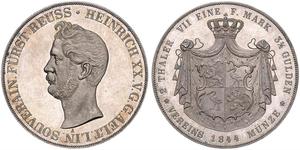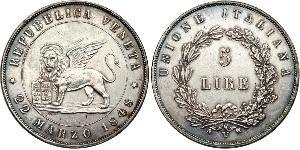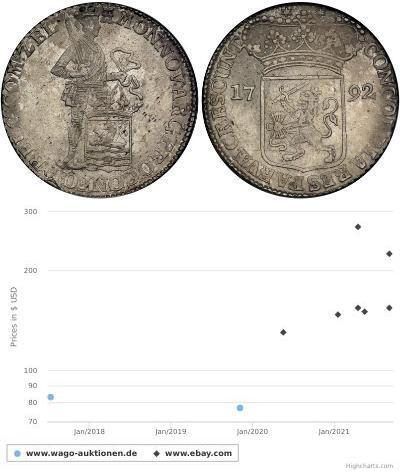(sold for $35.0)
1842, Kingdom of Naples, Ferdinand II. Large Silver 120 Grana (Scudo) Coin. VF+
Mint Year: 1842 Denominations: 120 Grana (Scudo) Reference: Davenport 174, KM-346. Condition: Light edge-hits, numerous bag-marks from circulation, toning spots, otherwise VF+ Weight: 27.33gm Diameter: 37mm Material: Silver
Obverse: Head of Ferdinand II of Bourbon as King of the Two Sicilies right. Date (1842) below. Legend: FERDINANDVS II DEI GRATIA REX 1842 Reverse: Crowned shield, Latin Kingdom of the Two Sicilies and Jerusalem. Legend: REGNI VTR. SIC. ET HIER. G.120
The Kingdom of the Two Sicilies (Neapolitan: Regno d’ ’e Ddoje Sicilie; Sicilian: Regnu dî Dui Sicili; Italian: Regno delle Due Sicilie; Spanish: Reino de las Dos Sicilias) was a kingdom located in Southern Italy from 1816 to 1860. The kingdom was the largest sovereign state by population and size in Italy prior to Italian unification, comprising Sicily and all of the peninsula of Italy south of the Papal States, covering most of the area of today's Mezzogiorno.
The kingdom was formed when the Kingdom of Sicily merged with the Kingdom of Naples, which was officially also known as the Kingdom of Sicily. Since both kingdoms were named Sicily, they were collectively known as the "Two Sicilies" (Utraque Sicilia, literally "both Sicilies"), and the unified kingdom adopted this name. The King of the Two Sicilies was overthrown by Giuseppe Garibaldi in 1860, after which the people supposedly voted in a plebiscite to join the Savoyard Kingdom of Sardinia. The annexation of the Kingdom of the Two Sicilies completed the first phase of Italian unification, and the new Kingdom of Italy was proclaimed in 1861.
The Two Sicilies were heavily agricultural, like the other Italian states.
Authenticitcy unconditionally guaranteed.
Ferdinand II (Ferdinando Carlo, January 12, 1810 – May 22, 1859) was the King of the Two Sicilies from 1830 until his death.
Ferdinand was born in Palermo, the son of King Francis I of the Two Sicilies and his wife and first cousin Maria Isabella of Spain.
His paternal grandparents were King Ferdinand I of the Two Sicilies and Queen Marie Caroline of Austria. His maternal grandparents were Charles IV of Spain and Maria Luisa of Parma.
Ferdinand I and Charles IV were brothers, both sons of Charles III of Spain and Maria Amalia of Saxony.
In his early years he was fairly popular. Progressives credited with Liberal ideas and in addition, his free and easy manners endeared him to the so-called lazzaroni, the lower classes of Neapolitan society.
On succeeding to the throne in 1830, he published an edict in which he promised to give his most anxious attention to the impartial administration of justice, to reform the finances, and to use every effort to heal the wounds which had afflicted the Kingdom for so many years. His goal, he said, was to govern his Kingdom in a way that would bring the greatest happiness to the greatest number of his subjects while respecting the rights of his fellow monarchs and those of the Roman Catholic Church.
The early years of his reign were comparatively peaceful: he cut taxes and expenditures, had the first railway in Italy built (between Naples and the royal palace at Portici), his fleet had the first steamship in the Italian Peninsula, and he had telegraphic connections established between Naples and Palermo (Sicily).
However, in 1837 he violently suppressed Sicilian demonstrators demanding a constitution and maintained strict police sureveillance in his domains. Progressive intellectuals, who were motivated by visions of a new society founded upon a modern constitution, continued to demand for the King to grant a constitution and to liberalize his rule.
In September 1847, violent riots inspired by Liberals broke out in Reggio Calabria and in Messina and were put down by the military. On January 12, 1848 a rising in Palermo, Sicily, spread throughout the island and served as a spark for the Revolutions of 1848 all over Europe.
After similar revolutionary outbursts in Salerno, south of Naples, and in the Cilento region which were backed by the majority of the intelligentsia of the Kingdom, on January 29, 1848 King Ferdinand was forced to grant a constitution patterned on the French Charter of 1830.
A dispute, however, arose as to the nature of the oath which should be taken by the members of the chamber of deputies. As an agreement could not be reached and the King refused to compromise, riots continued in the streets. Eventually, the King ordered the army to break them and dissolved the national parliament on March 13, 1849. Although the constitution was never formally abrogated, the King returned to reigning as an absolute monarch.
During this period, Ferdinand showed his attachment to Pope Pius IX by granting him asylum at Gaeta. The pope had been temporarily forced to flee from Rome following similar revolutionary disturbances. (see Roman Republic (19th century), Giuseppe Mazzini.
Meantime Sicily proclaimed its independence under the leadership of Ruggeru Sèttimu, who on April 13, 1848 declared the King deposed. In response, the King assembled an army of 20,000 under the command of General Carlo Filangieri and dispatched it to Sicily to subdue the Liberals and restore his authority. A naval flotilla sent to Sicilian waters shelled the city of Messina with "savage barbarity" for eight hours after its defenders had already surrendered, killing many civilians and earning the King the nickname "Re` Bomba" ("King Bomb").
After a campaign lasting close to nine months, Sicily's Liberal regime was completely subdued on May 15, 1849.
Only 1$ shipping for each additional coin purchased!

|
Posted by:
anonymous 2020-12-23 |
1/2 Cent Kingdom of the Netherlands (1815 - ) Copper William ...
group has 10 coins / 10 prices
⇑















-300-150-ZwusHgTycaAAAAGPadNVj7Mq.jpg)







